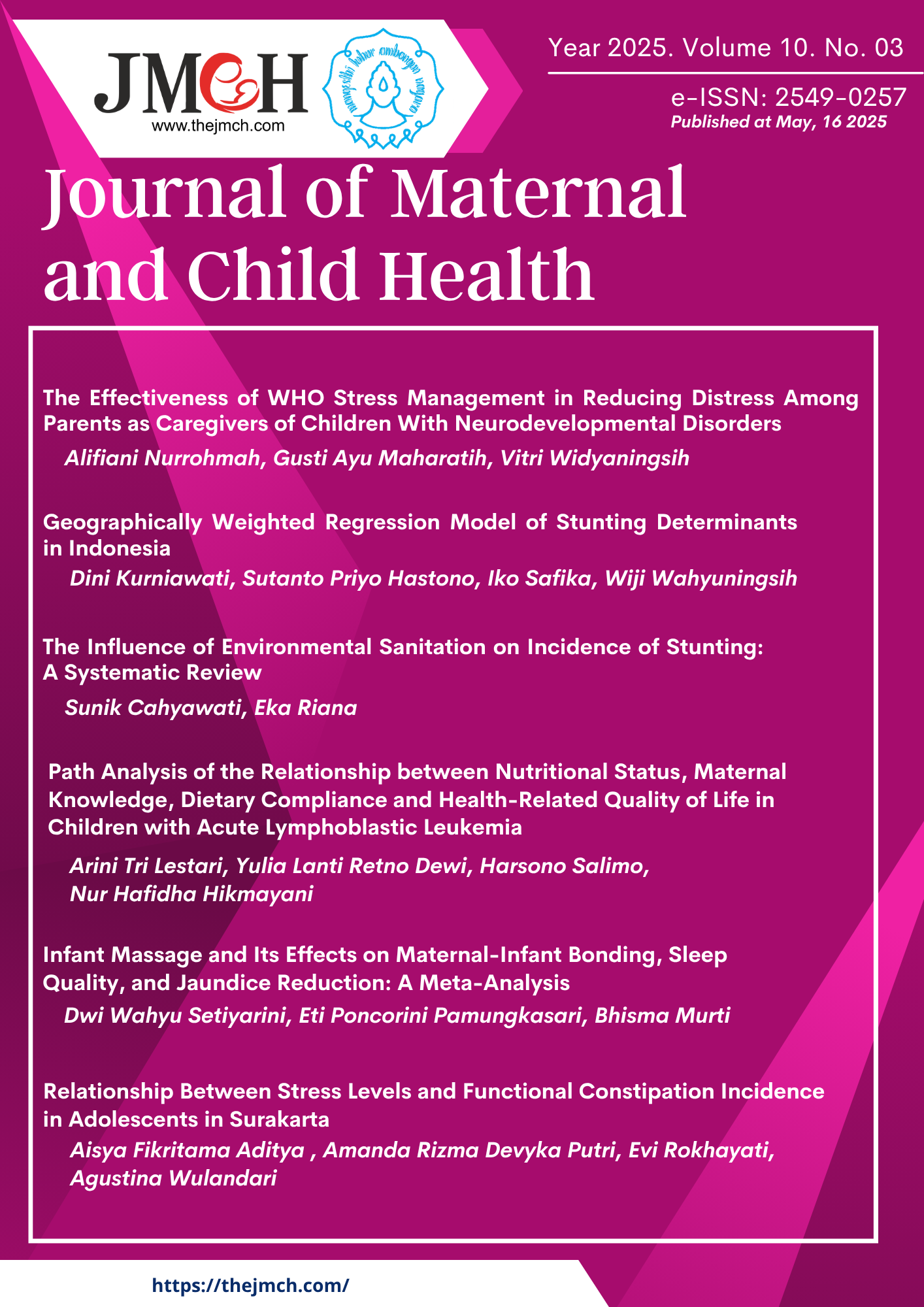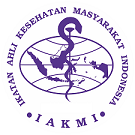Relationship Between Stress Levels and Functional Constipation Incidence in Adolescents in Surakarta
DOI:
https://doi.org/10.26911/thejmch.2025.10.03.06Abstract
Background: Adolescence is a time when physical and mental changes occur. They experience various mental pressures and can affect digestive health. One of the common digestive problems in adolescents is constipation. Constipation is a condition of bowel movement disorders characterized by infrequent or less than three times a week defecation or painful defecation due to hard or large-caliber feces. The purpose of this study was to determine the relationship between stress levels and functional constipation incidence among 10th grade adolescents at SMA Negeri 1 Surakarta.
Subjects and Method: This was a cross-sectional study conducted at SMA Negeri 1 Surakarta. A total of 308 students of Class X selected with the conseutive sampling method. The dependent variable was constipation. The independent variables was stress levels. Te data were collected by questionairre. The sample results of the study were analyzed using SPSS software using univariate tests and chi-square bivariate tests.
Results: The incidence of stress level did not have a significant relationship to the incidence of functional constipation in adolescents (OR= 0.77; 95% CI = 0.25 to 2.37; p = 0.551).
Conclusion: There is no relationship between stress levels and functional constipation incidence in adolescents in Surakarta.
Keywords:
adolescents, Functional Constipation, stress levelReferences
Arma DAWSN, Lucintarillova B, Lubis A, Putri N (2024). Hubungan tingkat pendidikan dan pendapatan orangtua terhadap kesehatan mental siswa Kota Bukittinggi 1,2,3,4 (The relationship between the level of education and parental income on the mental health of students in Bukittinggi city 1,2,3,4). 9(1):188–196.
Aryaningrum DI (2023). Hubungan Antara tingkat stres dengan kejadian premenstrual syndrome pada remaja putri kelas 3 SMAN 9 Semarang (The relationship between stress levels and the incidence of premenstrual syndrome in female adolescents in grade 3 of SMAN 9 Semarang). Thesis: Semarang: Undergraduate Nursing Study Program, Ngudi Waluyo University, Ungaran.
Asfiana NW (2015). Hubungan tingkat penghasilan dengan tingkat stres kepala keluarga penduduk Dukuh Klile Desa Karangasem Kecamatan Bulu Kabupaten Sukoharjo (The relationship between income levels and stress levels of heads of families in Klile Hamlet, Karangasem Village, Bulu District, Sukoharjo Regency). Thesis. Universitas Muhammadiyah Surakarta, 151: 9–11.
Azzahra N (2022). Faktor-faktor yang berhubungan dengan konstipasi fungsional pada siswa-siswi SMK Negeri 1 Ciomas Tahun 2022 (Factors related to functional constipation in students of SMK Negeri 1 Ciomas in 2022). Universitas Islam Negeri Syarif Hidayatullah Jakarta. Retrieved from: https://repository.uinjkt.ac.id/dspace/handle/123456789/67290
Bigliardi R, Arrúa A, Iramain R, Vighi S, Barone L, Regules G, Ballari D (2021). Functional constipation in pediatrics, diagnosis and treatment, Archives Argentinos De Pediatria, 119(1):S39–S47. Retrived from: https://www.ncbi.nlm.nih.gov/books/NBK537037/
Chu B, Marwaha K, Sanvictores T, Ayers D (2023). Physiology, stress reaction. stat pearls. Retrieved from: https://www.ncbi.nlm.nih.gov/books/NBK541120/
Classen M, Righini-Grunder F, Schumann S, Gontard AV, Laffolie J (2022). Constipation in Children and Adolescents. Dtsch Arztebl Int. 119(41):697-708. doi: 10.3238/arztebl.m2022.0309.
Cohen S (1994). Perceived stress scale. Retrieved from: https://www.northot-tawawellnessfoundation.org/wp-content/uploads/2018/04/PerceivedStressScale.pdf
Coss-Adame E (2013). Brain–Gut Axis In Constipation, In book: Constipation: Current & Emerging Treatments. DOI: 10.2217/EBO.12.365
Damayanti I, Mantu MR (2018). Hubungan antara status gizi dengan konstipasi pada pelajar kelas XI SMAN 14 Jakarta Timur Periode Januari 2018 (The relationship between nutritional status and constipation in grade XI students of SMAN 14 East Jakarta in the January 2018 period). Universitas Tarumanegara. Retrived from: http://repository.untar.ac.id/id/eprint/16520
Devanarayana NM, Rajindrajith S (2010). Association between constipation and stressful life events in a cohort of Sri Lankan children and adolescents. J Trop Pediatr. 56(3):144-8. doi: 10.1093/tropej/fmp077.
Dewi C, Wahyu W (2021). Asosiasi Aktivitas fisik dengan sembelit pada mahasiswa Sekolah Ilmu Kesehatan Makassar (Association of physical activity with constipation in students of Makassar School of Health Sciences). J-Kesmas: Jurnal Kesehatan Masyarakat, 7(1):1.
Diaz S, Bittar K, Hashmi MF, Mendez MD (2023). Constipation, Stat pearls Publishing. Retrieved from: https://www.ncbi.nlm.nih.gov/books/NBK513291/
Dos Santos IR, de Abreu GE, Dourado ER, Martinelli Braga AAN, Lobo VA, de Carvalho IWB, Bastos Netto JM, Barroso U Jr (2021). Emotional and behavioural problems in children and adolescents: The role of constipation. J Paediatr Child Health. 57(7):1003-1008. doi: 10.1111/jpc.15368.
Drossman AD (2016). Rome IV Diagnostic Criteria for Disorder of Gut-Brain Interaction (DGBI). 162(3): 675-679. Retrieved from: https://www.gastrojournal.org/article/S00165085(21)03794X/fulltext
de Carvalho EB, Vitolo MR, Gama CM, Lopez FA, Taddei JA, de Morais MB (2006). Fiber intake, constipation, and overweight among adolescents living in Sao Paulo City. Nutrition. 22(78):744-9. doi: 10.1016/j.nut.2006.05.001.
Ebisutani N, Fukui H, Nishimura H, Nakanishi T, Morimoto K, Itou S, Nakamura A, et al. (2020). Decreased colonic guanylin/ uroguanylin expression and dried stool property in mice with social defeat stress. Front Physiol. 11:599582. doi: 10.3389/fphys.2020.599582.
Elvita SD (2015). Faktor dominan terhadap kejadian konstipasi fungsional pada siswa SMA Islam Al-Azhar Pejaten Jakarta Selatan Tahun 2015 (Dominant factors in the occurrence of functional constipation in students of Al-Azhar Islamic High School, Pejaten, South Jakarta in 2015). Thesis. Universitas Indonesia.
Gozali FS, Febiana B, Putra IGNS, Karyana IPG, Hegar B (2023). Relationship between psychological stress with functional constipation in children: a systematic review. Pan Afr Med J. 46:8. doi: 10.11604/pamj.2023.46.8.41130.
Has DFS, Srirahayu Ariestinigsih E (2022). Correlation between parent’s economic level and boredom in learning with stress among students during covid-19 pandemic. Indonesian Journal of Community Health Nursing, 7(2):68–73. Retrieved from: https://e-journal.unair.ac.id/IJCHN/article/view/39464
Indira E (2016). Stress questionnaire: stress investigation from dermatologist perspective, Psychoneuroimmunology in Dermatology, Pp. 141–142.
Jani B, Marsicano E (2018). Consti Pati on: evaluation and management, Missouri Medicine, 115(3):236–240.
Juliana D (2022). Hubungan Antara stres dengan gejala gangguan pencernaan pada remaja di Desa Andamui Kecamatan Ciwaru Tahun 2022 (The Relationship Between Stress and Symptoms of Digestive Disorders in Adolescents in Andamui Village, Ciwaru District in 2022)
Levy EI, Lemmens R, Vandenplas Y, Devreker T (2017). Functional constipation in children: Challenges and solutions. Pediatric Health, Medicine and Therapeutics, 8:19–27.
Liu YZ, Wang YX, Jiang CL (2017). Inflammation: The Common Pathway of Stress-Related Diseases. Front Hum Neurosci. 11:316. doi: 10.3389/fnhum.2017.00316.
Macêdo MIP, Albuquerque MFM, Tahan S, Morais MB (2020). Is there any association between overweight, physical activity, fat and fiber intake with functional constipation in adolescents? Scand J Gastroenterol. 55(4): 414-420. doi: 10.1080/00365521.2020.1749878.
Van Mill MJ, Koppen IJN, Benninga MA (2019). Controversies in the management of functional constipation in children. Curr Gastroenterol Rep. 21(6):23. doi: 10.1007/s1189401906909
Mohajan H (2017). Two criteria for good measurements in research: validity and reliability. Annals Of Spiru Haret University. DOI: http://dx.doi.org/10.26458/1746
Musdja MY, Azrifitria (2007). Farmakoterapi saluran cerna (Gastrointestinal pharmacotherapy).
Parra-Mujica F, Lewer D, McCabe L, Ashworth M, Cann P, Anderson R, Holland R (2023). Understanding The relationship between income and mental health among 16 to 24-year-olds: analysis of 10 waves (2009–2020) of understanding society to enable modelling of income interventions, Plos One, 18(2):1–22. doi: 10.1371/journal.pone.0279845.
Shalahuddin NI (2017). Hubungan tingkat aktivitas fisik dengan konstipasi pada ibu hamil di Puskesmas Pucangsawit Kota Surakarta (The relationship between physical activity levels and constipation in pregnant women at the Pucangsawit Community Health Center, Surakarta City). Thesis. Universitas Sebelas Maret.
Stephen (2017). Hubungan tingkat stres dengan kejadian konstipasi pada Mahasiswa Fakultas Kedokteran Universitas Sumatera Utara Stambuk 2015 (The relationship between stress levels and the incidence of constipation in students of the Faculty of Medicine, University of North Sumatra, Stambuk 2015). Thesis. Universitas Sumatera Utara.
Sugiantoro MI, Surialaga S, Putri M (2023). Hubungan aktivitas fisik dan konsumsi air dengan konstipasi pada Mahasiswa Kedokteran Universitas Islam Bandung (The relationship between physical activity and water consumption with constipation in medical students at the Islamic University of Bandung). Jurnal Integrasi Kesehatan & Sains, 5(2):150–54.
Thea F, Sudiarti T, Djokosujono K (2020). Faktor dominan kejadian konstipasi fungsional pada remaja di Jakarta (Dominant factors in the occurrence of functional constipation in adolescents in Jakarta). Jurnal Gizi Klinik Indonesia, 16(4):129.
Tran DL, Sintusek P (2023). Functional constipation in children: what physicians should know, World Journal of Gastroenterology, 29(8):1261–1288.
Tsigos C, Kyrou I, Kassi E, Chrousos GP (2020). Stress: Endocrine Physiology and Pathophysiology. Endotext [Internet]. South Dartmouth (MA): MD-Text.com, Inc.; 2000. PMID: 25905-226.
World Gastroenterology Organisation (2024). Constipation. Retrived from: https://www.worldgastroenterology.org/guidelines/constipation
Yamada M, Sekine M, Tatsuse T, Fujimura Y (2021). Lifestyle, Psychological stress, and incidence of adolescent constipation: results from the toyama birth cohort study. BMC Public Health, 21(1):1–9. doi: 10.1186/s12889020100445.
Yang D, Hu S, Li M (2022). The Influence of Family Socioeconomic Status on Adolescents' Mental Health in China. Int J Environ Res Public Health. 19(13):7824. doi: 10.3390/ijerph19137824.
Yuwanita N, Sinuhaji AB, Sembiring T, Supriatmo, Yudiyanto AR (2018). Obesity and functional constipation in children. Paediatrica Indonesiana. 58(1):1–4. doi: 10.14238/pi58.1.2018.14.











